4 Ways to Know If a Snake Is Venomous, According to Experts
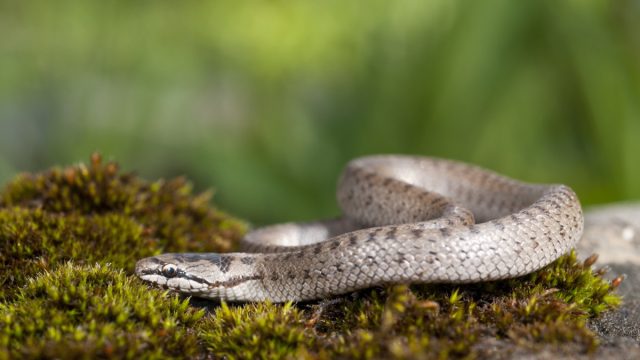
The only thing worse than a snakebite is a venomous snakebite. Though rare—researchers estimate that just 10 to 15 percent of snakes are venomous—snake venom is clearly something you don’t want coursing through your veins. Symptoms from a venom-packed bite can range from obvious (pain, bleeding, nausea) to unexpectedly dangerous (you stop breathing in rare cases). The easiest way to avoid a bite is to know when a snake is venomous. “There isn’t any single rule of thumb to identify venomous snakes,” Sholom Rosenbloom, the owner of Rosenbloom Pest Control, tells Best Life. But there are some general visual tells that work in most situations. Read on to learn from experts about the four most common ways to know if a snake is venomous.
READ THIS NEXT: It’s Snake Bite Season: “Stay Away” From These Areas, Officials Warn.
1
Do your research.
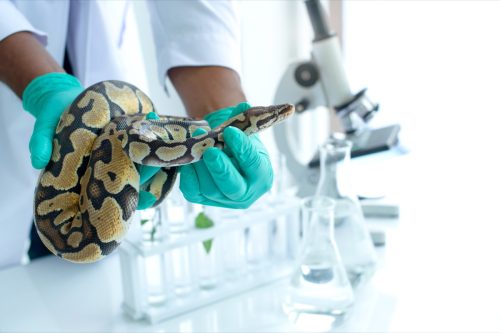
Snakes are hyper-regional, and there are more varied species of snake on the planet than you can shake a stick at. (For instance, you’ll find roughly three dozen different species of rattlesnakes in North America alone.) In many cases, the difference between a venomous snake and a non-venomous one is negligible without close scrutiny. If you’re concerned, you should brush up on your region’s local variants so you can identify the dangerous ones on the fly.
Rosenbloom cited the example of a striped snake where red patterning merges with black stripes, which can sometimes mean you’ve encountered a coral snake—a rare but extremely venomous creature. But coral snakes do have their imitators. “It may be a look-a-like,” Rosenbloom says. “The only real way is to pay attention to detail and to know what the local venomous snakes look like. And that involves knowing what their nonvenomous imitators look like as well.”
One easy way to spot mimics: Critterpedia, which is an app, currently in beta, that more or less works as a “Shazam for spiders and snakes,” Smithsonian reports. Snap a photo of a snake, and it’ll compare it to a local database of other creatures in your area using AI-backed tech.
READ THIS NEXT: The First Place You Should Check for a Snake in Your Home, Experts Say.
2
Look at its eyes.
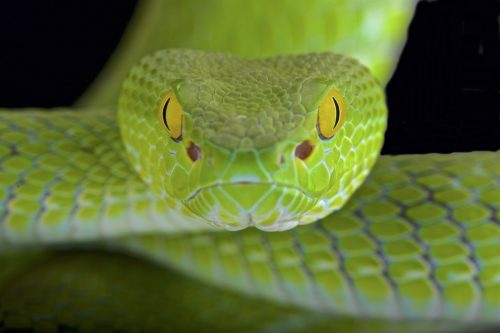
That said, there are some generalities to keep an eye out for—like, well, their eyes. It’s not like a snake will engage you in a staring contest, per se, but if you’re able to get a glimpse, the shape can be telling. “Their pupils will be an elliptical shape instead of round” if they’re venomous, Jeremy Yamaguchi, the CEO of Lawn Love, a tech and yard care company, tells Best Life.
3
Check the shape of its head.
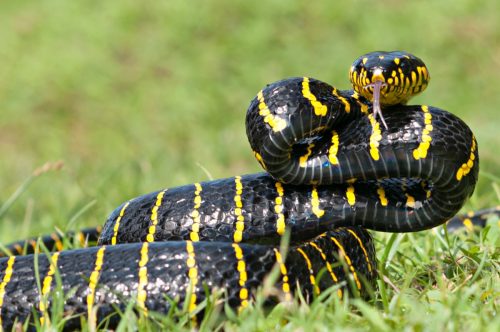
Yamaguchi says observing the shape of a snake’s head is another visual clue. “Venomous snakes will often have broader heads, due to their venom sacs.” According to Josh Snead, the CEO of Rainwalk Pet Insurance, “they might also have pits or holes on their snouts, which is where the name pit viper comes from.”
RELATED: For more up-to-date information, sign up for our daily newsletter.
4
Absolute worst case: Assess the bite.
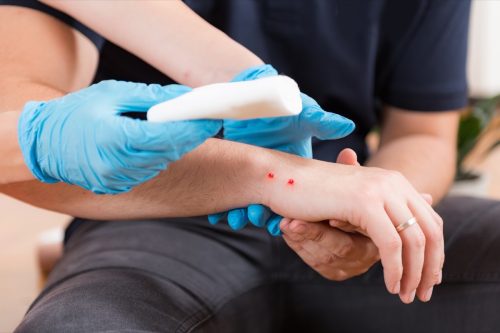
Sometimes, you won’t know whether or not a snake is venomous until it’s already too late. To be crystal clear, in all situations where you’ve been bitten by a snake, you should seek medical attention, stat. (The National Capital Poison Center is reachable via phone all day, every day, at 1-800-222-1222.) But in the case of a dire emergency—say, if you’re on a hiking trail, far from civilization and cell reception—you can also run some tests on yourself. The first is a quick visual test.
“If two or four prominent bite marks are there, it is most likely a venomous snake bite,” Rosenbloom says. “If there [are] two diverging rows of multiple bite marks, it can be non-venomous.”
Another option, Rosenbloom suggests, is to perform what’s known as a “20 minutes whole blood clotting time test.” Invented by researchers in the late 1970s, the test is pretty simple: Put a little bit of blood (around a few millimeters) in a clean container. After 20 minutes, turn the container on its side. If the blood failed to coagulate, that’s a potential sign you’ve been bitten by a venomous creature.
Of course, the single best method to avoid getting infected by a venomous snake is also the simplest: Steer clear of getting bitten by one in the first place. “You often can’t get a good enough look at [a] snake that crosses your path,” Yamaguchi says. “Your best choice is always going to be to get away from any snake you come across.”